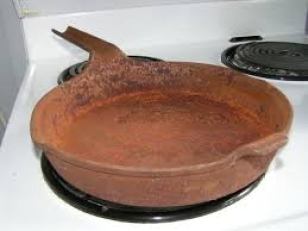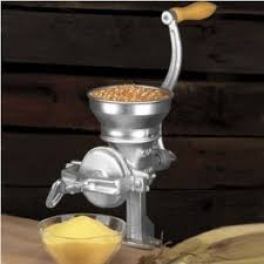Cast Iron
 The cornerstone of any survivalist, prepper or primitive living-type kitchen is a healthy rack of cast iron. Once nearly extinct in the late 20th Century, cast iron is experiencing a rapid and very welcome resurgence amid people slowly but surely rejecting modernism in lieu of a simpler and more sustainable life. But re-learning the ways of yore comes with challenges. Cast Iron is not plug and play; it takes a bit of care and preparations in order to gain the best results and in the case of grinders, not damage the tools themselves.
The cornerstone of any survivalist, prepper or primitive living-type kitchen is a healthy rack of cast iron. Once nearly extinct in the late 20th Century, cast iron is experiencing a rapid and very welcome resurgence amid people slowly but surely rejecting modernism in lieu of a simpler and more sustainable life. But re-learning the ways of yore comes with challenges. Cast Iron is not plug and play; it takes a bit of care and preparations in order to gain the best results and in the case of grinders, not damage the tools themselves.
As stated, these are things that used to be common knowledge. In my relatively brief life, luckily I learned the value of great living that I would later come to know as Survivalism early on. Sadly those Depression-era vessels of knowledge are dying off, and only a fraction of our current population seem to retain what’s being lost. Regardless, let’s do our part to spread the knowledge- it’s coming back and its certainly a welcome sight among modern ‘wonder kitchen wear’ which feature unnatural and potentially dangerous chemicals when compared to simple iron with a lard cure.
 Cast Iron requires a decent amount of attention before being used, but once done properly, will last your lifetime and most likely that of your kids, probably longer. I’m not a fan of “non-stick” junk or tools that otherwise are meant to be used for a while then thrown away. Aside from being potentially dangerous, they typically don’t hold up long when used anywhere other than a home kitchen. To me, it’s a waste of resources and promotes materialism. Cast Iron in many places is considered a family heirloom- often times at least one generation old. Today’s households are having to often buy new as they’re rediscovering the value of Cast Iron cookware. Every family should have at a minimum one Large Pan, one Small Pan and a Dutch Oven. The Large Pan for general purpose frying, the Small for smaller meals or making cornbread, and the Dutch Oven for deep frying, cooking chicken, pot roasts, etc, or making huge pots of chili or stew in the winter.
Cast Iron requires a decent amount of attention before being used, but once done properly, will last your lifetime and most likely that of your kids, probably longer. I’m not a fan of “non-stick” junk or tools that otherwise are meant to be used for a while then thrown away. Aside from being potentially dangerous, they typically don’t hold up long when used anywhere other than a home kitchen. To me, it’s a waste of resources and promotes materialism. Cast Iron in many places is considered a family heirloom- often times at least one generation old. Today’s households are having to often buy new as they’re rediscovering the value of Cast Iron cookware. Every family should have at a minimum one Large Pan, one Small Pan and a Dutch Oven. The Large Pan for general purpose frying, the Small for smaller meals or making cornbread, and the Dutch Oven for deep frying, cooking chicken, pot roasts, etc, or making huge pots of chili or stew in the winter.
If buying new- buy American! Lodge still makes products in the US, and is the only one that I know of that does. One annoying thing that they do is ship their pieces with a non-stick coating, which in my experience turns into a mess after a while. Remove this by soaking the pan in hot soapy water and scrubbing, then allowing to air dry. Once done you’re left with bare metal and a generally rough casting. I use an orbital sander to smooth this out. Once done get a can of Crisco or even better, Lard, and liberally coat the iron. Set the oven to the self clean mode if you have it, or 450 deg, and bake the pan upside down for an hour. Put a drip rack underneath the pan to stop any drippings from falling on the heating element. This process will stink. Make sure you open a window.
 If finding one used, sometimes a great bargain can be found if not in a good condition, such as a rusty one seen here. The easiest way to clean them, as I did two very old belted kettles I inherited, is to first rough the rust up with course sand paper, then soak them in a cola and lime juice mix. The acidity of the liquid will remove the rust after a few days. Allow it to dry, then go through the seasoning process I detailed above. You’ll have a perfectly serviceable piece of cast iron made new once again to last a lifetime.
If finding one used, sometimes a great bargain can be found if not in a good condition, such as a rusty one seen here. The easiest way to clean them, as I did two very old belted kettles I inherited, is to first rough the rust up with course sand paper, then soak them in a cola and lime juice mix. The acidity of the liquid will remove the rust after a few days. Allow it to dry, then go through the seasoning process I detailed above. You’ll have a perfectly serviceable piece of cast iron made new once again to last a lifetime.
While using, keep in mind that cast iron is different from modern pans; they heat up slow, and hold that heat for a long time. You also don’t need as much heat in order to fry. Most of the time medium heat works just fine. Regular maintenance is pretty simple; rub it down with vegetable oil every once in a while, and the seasoning will stay fresh. Do not wash the pans. Wipe them down to clean them.
 The same needs to be done to your grinding tools such as hand crank meat grinders or food choppers. They’re made of cast iron too. Often, when looking at reviews online, many get bad ratings stating that metal shavings get ground into the food. This happens because like all metal machines, the moving parts need lubricant. Since each of them are cast iron, the same process for caring for your kitchen tools should be done to protect them from premature wear or risk of food contamination. The only other caveat to this is when cleaning meat grinders, use hot water and rubbing alcohol, and your seasoning should be maintained just fine.
The same needs to be done to your grinding tools such as hand crank meat grinders or food choppers. They’re made of cast iron too. Often, when looking at reviews online, many get bad ratings stating that metal shavings get ground into the food. This happens because like all metal machines, the moving parts need lubricant. Since each of them are cast iron, the same process for caring for your kitchen tools should be done to protect them from premature wear or risk of food contamination. The only other caveat to this is when cleaning meat grinders, use hot water and rubbing alcohol, and your seasoning should be maintained just fine.
The ability to process and cook food with equipment that will last a lifetime while being perfectly serviceable off the grid is well worth its weight in gold. None of these items are super expensive compared to the ridiculous amounts of money some spend on tacticool bullshit and playing Walter Mitty, wannabe Infantry. The cornerstone of a successful Survivalist model should be sustainability, which these tools are. Further, with good sets of tools, good communities can be rebuilt. You should be able to bring as much to the table as possible, and a warm properly prepared meal when people are starving from the inability to cook is a great way to build loyalty, post-collapse, pre-collapse, or any time in between.
Share This Story, Choose Your Platform!
7 Comments
Comments are closed.





































4.5
I just started cooking with cast iron. I was a little disappointed with the Lodge pan because it had a spot of rust. But, they’re web page has excellent instructions. I scrubbed it as you say and then followed their instructions for seasoning it. I didn’t, and wouldn’t use their spray on season. No telling what’s in It. Speaking of which, please don’t use Crisco, it’s poison. I hadn’t heard of using lard. I’ll have to try it. I use simple extra virgin olive oil. Seems to wipe up nice after use and I just put a very very thin coat back down after each use. This is what Lodge says to do more or less. One of the great things about cast iron is you can use stainless utensils to cook with because scraping doesn’t matter. So no more dirty wooden or Chicom poison plastic spatulas! I also noticed the temp settings need to be lower as you mentioned. I was cooking eggs and they get away from you fast if the cast iron is used with the same temp as a synthetically coated pan. Also no telling what’s in those coatings. Their deemed to be safe, until they’re not. I think I’m going to make some liver and onions. It’s incredibly good for you and that’s why momma used to make us eat every once in a while.
Also looking at Lacto Fermentation of veggies. Easy to do, thousands of years old across many cultures including Europe, and very good for the gut.
5
Good read, Thanks! Like Fred said, I use extra-virgin olive oil to season my irons. Less chance of getting rancid. By the way, PLEASE don’t use paper towels in the seasoning or cleaning of your cast iron–not unless you want all those white paper-shards and chads embedded in your pans and ovens! Your irons begin to look like “Santa Claus” with a white “beard” on the cooking surface. Ever eat a fried egg with a beard?
Use a good quality lint-free cotton rag for same.
P.S.
Good tip using the orbital sander getting the surface down “just right!”
you can buy those old cast iron cheap rusted up at yard sales.
get a bucket of water . tie a rebar rod, to the side wall of the bucket.
hook up a battery charger cable to the pan . the other to the rebar.
dump in a box of baking soda
turn on the battery charger and you knock all the rust off of the pan , to look like new.
this is called reverse electrolisis.
i can’t remember if the cable have to go 1 way or the other. but i did a lot of old leg hold traps this way.
keep kids and pets away from the water..
Black great advice on using electrolysis,positive goes on the rebar as this becomes a sacrificial anode rod,neg to the pan.I have used this for tools/gas tanks ect.,a great process and simple,now I just need a yard sale.I have a lot of stainless cookware that avoids all the coatings/need to use plastic utensils ect. but would like to add cast,and,can’t imagine most folks in the market to buy rusty cooking equipment(hopefully).
Side note,I use old carriage bolts instead of rebar,the ends got sacrificed and made a point,now have a badd ass extra punch/nail set type of tool.
4